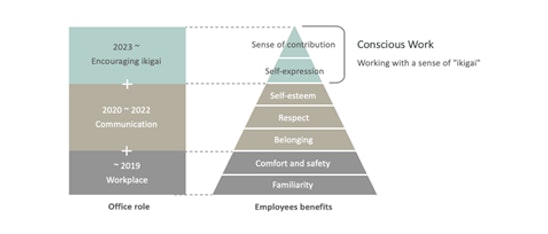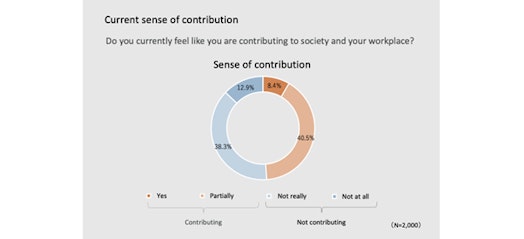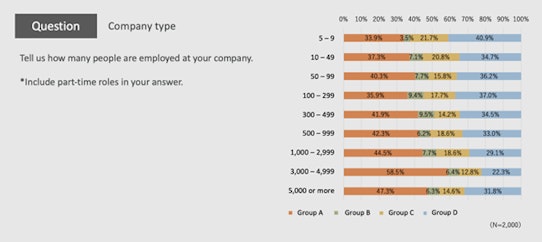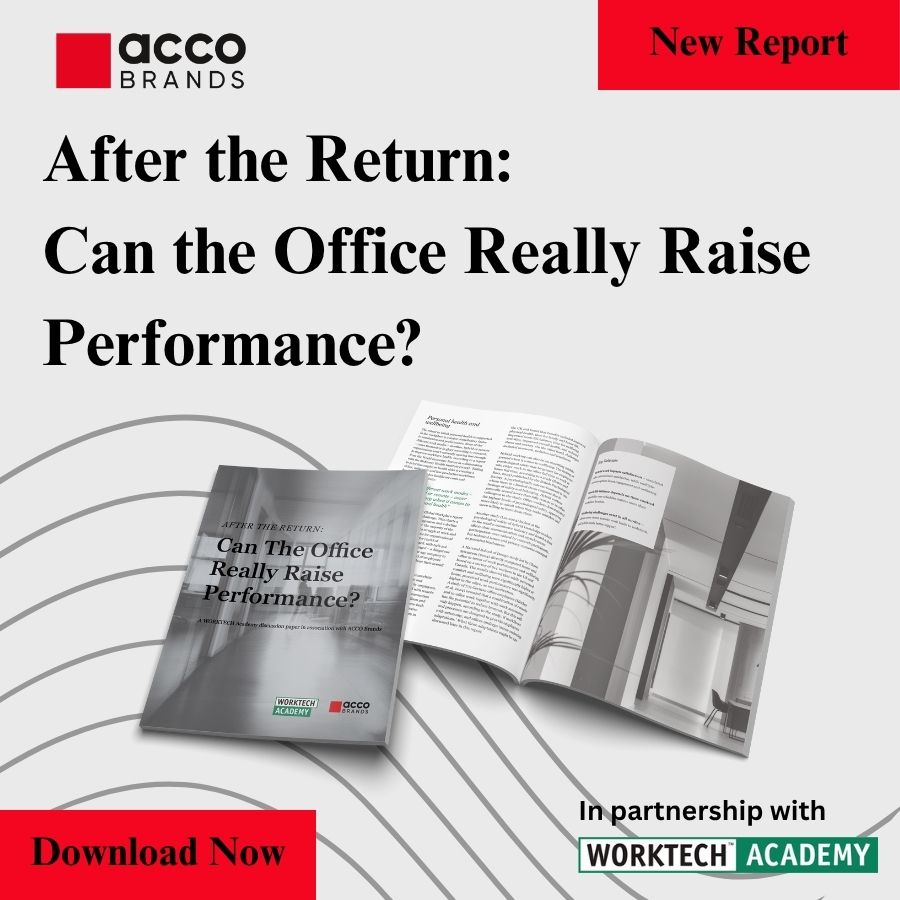Japanese survey reveals motivated workers’ new expectations of the workplace
A study of 2,000 Tokyo employees reveals that stress levels, self-improvement and expectations of the office vary, based on whether they feel they are contributing to their company and society, and whether they aspire to do so in the future
Offices have traditionally been places where employees go to get work done. With the widespread introduction of flexible and remote working, the office today has an additional – and important role – to enhance the culture and communication across an organisation.
Offices will also play a vital role in helping employees feel more fulfilled in their jobs in the future. This is a key prediction from Tokyo-based consulting firm Frontier Consulting founded from its latest Working Styles of Office Employees Survey conducted in November 2023. The survey investigates how workers with ‘ikigai’ – a Japanese concept based on how satisfied and motivated employees feel – perceive their work environment. Below are the results of that survey.
Defining ikigai
In this study of 2,000 office workers, Frontier Consulting defined an employee as having ‘ikigai’ for their job — e.g. having motivation and being purpose-driven — if the worker feels they are contributing to the workplace and society and can achieve self-actualisation. The survey also referred to working with a sense of ikigai as ‘conscious work,’ and the workers who practice it as ‘conscious workers.’

Frontier Consulting’s survey analysed responses from respondents with a strong sense of contribution to understand how conscious workers perceive their working environment. The study also explored the preferred environments that enhance work satisfaction.
Four worker types
The survey first examined the extent to which employees felt they contributed and their desire to contribute to society and their workplace. Almost half (48.9 per cent) of employees felt that they were contributing to some degree. When asked, ‘Would you like to feel that you are contributing more to society and your workplace?’ almost 60 per cent indicated that they would.


Workers were then classified into four groups based on current contribution and future tendencies:
Contributing and future tendency to contribute (Group A): Two in five (41.6 per cent) of workers fall into this category – feeling like they are contributing and have a desire to contribute more.
Contributing but no future tendency to contribute (Group B): Just 7.4 per cent of employees currently feel they are contributing but do not desire to contribute more.
Not contributing but has a future tendency to contribute (Group C): Almost one fifth (17.4 per cent) of workers do not currently feel they are contributing but desire to contribute more.
Not contributing and no future tendency to contribute (Group D): A third of workers (33.8 per cent) do not currently feel they are contributing and do not desire to contribute more.

Trends by company type and size
The study also analysed the size of the companies (publicly traded, private, or other) that participants worked at.
Those who are contributing and have a future tendency to contribute (Group A) were more prevalent in ‘public’ and ‘other’ companies, while those who are not contributing and have no future tendency to contribute (Group D) were more common in private companies.

Public companies generally have significant market shares and social influence, which could create frequent opportunities for their employees to feel a sense of contribution to the company and society. Additionally, companies in the ‘other’ category often include non-profit organisations, where employees generally have a strong awareness of working for the betterment of society, making it probable that there are many Group A workers at non-profits as well.
When comparing companies by the number of employees, the proportion of Group A increases as employees increase, up to companies with less than 5,000 employees. Conversely, the proportion of Group D decreases as the company size increases.
Differences in stress and motivation to learn
Respondents were also asked about stress felt in the workplace. In response to the multiple-choice question ‘Do you feel stressed at your workplace?’ Group A and Group B had a high proportion of respondents who responded that they were not feeling stressed or not very stressed.

On the other hand, groups C and D had a high proportion of respondents reporting feeling stressed. In particular, 12.6 per cent of Group C and 31 per cent of Group D reported feeling stressed, indicating a significant difference to the contributing worker groups.
The study also looked at motivation for learning among employees. Almost half (49 per cent) Group A responded that they are currently engaged in self-directed learning. However, only 15.9 per cent of Group D responded positively, indicating a significant disparity in motivation to learn.

Remote work for conscious workers
The study also included questions on work flexibility regarding location, time, and employment contracts. Location flexibility refers to whether telework or workcation is possible, and time flexibility refers to whether or not employees have flexible working hours. Employment contract flexibility refers to whether or not the employer allows outside work or switching employment status (e.g. from full-time to part-time).
As a result, Group A had the highest flexibility across location, time, and employment contracts at their workplaces. Furthermore, when asked about the importance of flexibility in location, time flexibility, and employment contracts in future working conditions, groups A and C placed importance on flexibility in all aspects.
Those with a lower sense of current contribution and future tendency to contribute reported that they have spent less time teleworking in the past six months than others.

On the other hand, all groups expressed a desire for more telework. Compared to Groups B and D, however, more respondents among Groups A and C expressed a preference for remote work.

Those who expressed a preference for remote work rates of 90 per cent (approximately one day in the office out of 10) or 100 per cent was about half as much in Group A when compared to Group D. There may be a tendency for these individuals to prefer coming into the office for at least one day per week, perhaps feeling that a certain amount of in-office attendance is necessary.

Groups A and C were also more likely to choose ‘able to participate in outside communities’ as a benefit of remote work. On the other hand, the proportion of those who selected ‘reduction in relationship stress at the office’ was higher among Groups B and D. It may be that those feeling a weaker sense of contribution do not seek communication as much.
How do conscious workers perceive the office?
So, what do conscious workers think about the office? When asked how they perceive the office, respondents in Groups A and C tended to view the office as a place for ‘teamwork and collaboration’ more than individuals in the other groups.
Moreover, those with higher levels of current contribution or future tendency to contribute were more likely to view the office as helpful in building trust with colleagues. On the other hand, groups B and D frequently responded that the office is a place for focused work.

Workcation for conscious workers
The study included questions on workcation, or working remotely while on vacation. More than a quarter of participants in the study answered that they already taken a workcation before and were asked ‘Do you think you would go on another workcation in the future?’ Survey respondents with a high sense of contribution or orientation were more likely they would. These answers accounted for 81.9 per cent of responses.

The other three-quarters of participants who hadn’t taken a workcation before were asked ‘Would you want to take a workcation in the future?’ Overall, participants who hadn’t been on a workcation before expressed weaker interest in taking one. However, participants from groups A and C had the most positive responses. The desire to go on a working vacation could be correlated with employees who are currently or desire to contribute in the future.

For respondents who said they wanted to go on another workcation in the future, those with lower levels of contribution tended to choose refreshment and relaxation as their reason at a higher rate. Conversely, those with higher levels choose reasons such as community revitalisation and increased productivity. Those with a high sense of contribution and future desire to contribute may also be thinking about business and societal benefits.

Results and implications for the office
This study finds that workers who have a sense of contribution to the workplace and society and desire to continue to contribute tend to experience lower stress in the workplace and have more self-motivation to learn.
Conscious workers showed a stronger desire for remote work and prioritised flexibility in the workplace. At the same time, these individuals also expressed a preference for working at the office for at least one day a week, indicating a perceived necessity for some office attendance. These individuals perceive the office as a place for teamwork and collaboration, and for building strong work relationships.
Conscious workers were also more likely to take more workcations in the future. They tended to view workcations as an opportunity to increase productivity and contribute to local communities.
These results suggest a need to be intentional in building offices that foster higher work satisfaction. As companies place increasing value on social responsibility, individual employees are also becoming more aware of the significance of contributing to society as a whole, making the role of the workplace all the more important.








